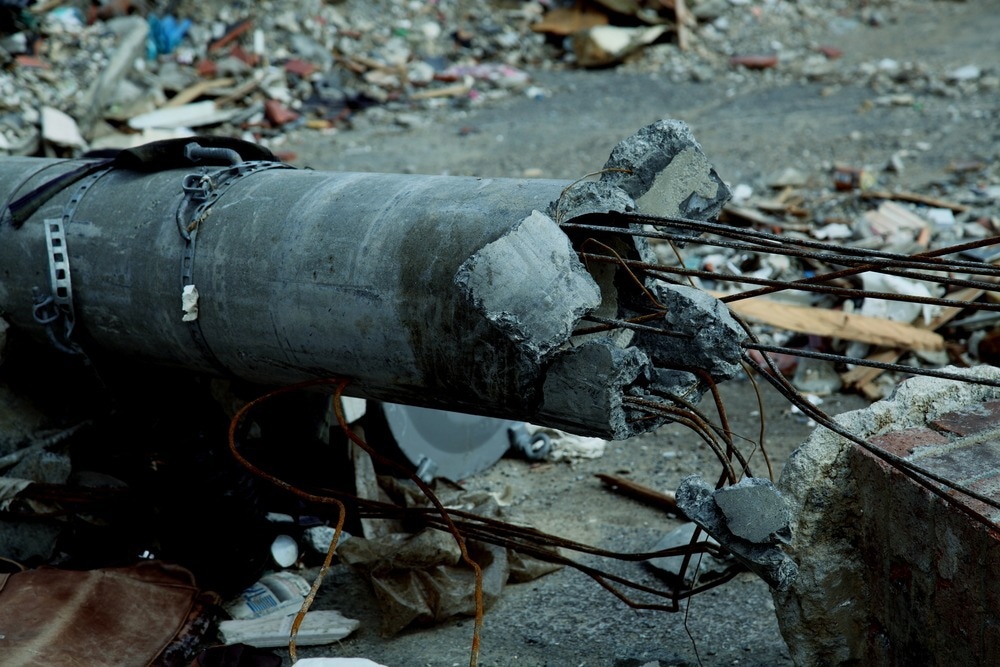This article discusses the risk of tsunamis to buildings in coastal regions and the strategies that can be implemented for tsunami-resistant building construction.

Image Credit: enase/Shutterstock.com
How Tsunamis Pose Risks to Buildings
Tsunamis are primarily a series of undulations generated by powerful earthquakes under large water bodies, such as seas and oceans. These earthquakes create a complex subsurface wave that can travel several hundred miles an hour until it reaches shorelines and shallow water.
In coastal regions, structures, specifically buildings, can be partially or fully damaged due to the impact of tsunami waves. The flow of water around/through the buildings that obstruct/resist the high-velocity water flow and the force of the water in a tsunami wave results in significant damage to these structures.
Tsunami waves are also dangerous as they carry a significant amount of debris. This debris carried by forceful water can destroy the piling, roof, or wall of a building. The wind forces with tsunami waves can also damage the buildings in coastal regions.
Moreover, tsunami waves rushing deep onto land and then retreating to the sea can create unexpected scouring and erosions of building foundations.
Strategies for Tsunami-Resistant Building Construction
Preserving the Rough Ground near the Shorelines
A smooth unprotected beach due to the removal of vegetation must be avoided as rough grounds can reduce the momentum of an incoming tsunami wave. Specifically, mangrove swamps can act as a natural buffer to effectively slow down tsunami waves. Additionally, the preservation of reefs by prohibiting their destruction for shipping channels can also minimize the effect of waves on coastal buildings.
Replacing Wood with Reinforced Concrete for Construction
Although wooden construction is more resilient to earthquakes as timber is a lightweight material, reinforced steel-frame or concrete structures are more suitable for the construction of tsunami-resistant buildings in tsunami-prone areas as wood can be easily uprooted, which can cause further damage to other buildings.
Implementing Tsunami-resistant Building Designs
Resistance mitigation can be achieved by designing structures that allow water to flow through them. Buildings located much above the ground level are also vulnerable to bigger tsunami waves.
Multi-story building structures can be built with suspended floors/open or breakaway first and ground floors to ensure that the major force of the water in tsunami waves can flow through these structures.
The structures can be designed with walls that fail at the ground-to-first-floor level and robust frames that can adequately support the floors above the first floor without any help from the walls.
Although this design recommendation leads to less structural damage as water flows underneath the structure, the design is site-specific and complicated as it is contrary to seismic practices.
The force of the tsunami can completely turn a solid, concrete building on its side, which necessitates the construction of deep substantive foundations that are braced at the footings.
In sandy soils, the footings must be deep, and the bracing must go down to the feet. Light soil can be protected from erosion by concrete surfacing underneath the building floor. A grillage of steel beams enclosed in a concrete floor can be used with moment connections to the columns below or at ground level to prevent scour and tipping.
Buildings must be designed to ensure that these structures can withstand partial failure without progressive collapse. Robust continuous steel framing can be used that can withstand hurricane-force winds. Structural connectors capable of absorbing stress can be designed to make a building tsunami-resistant.
Constructing Buildings in Safer Locations
Buildings must not be built at a low level on the shoreline above a smooth, shallow beach, specifically on the sides of inlets/canals, which can channel the waves and increase their force.
Ensuring Proper Positioning of Buildings
Buildings constructed close to each other can act as a wider dam blocking the tsunami wave, leading to significant structural damages. Thus, gaps must be maintained between the buildings to allow the water to dissipate effectively.
Moreover, these structures can be oriented at an angle to the shoreline as walls directly facing an approaching wave with full force suffer more damage. Tsunami waves are diverted around the sides after hitting the pointed corner of diagonal buildings/buildings that are angled to the shoreline, which reduces the pressure of the water on the buildings.
Recent Developments
Brahman Developments, based in Puerto Rico, has developed an affordable and innovative submarine-shaped reinforced concrete structure that can ride the waves during tsunamis and ensure the safety of all occupants within the structure.
The tubular structure is known as STATIM Shelter System, which can be tethered and also float freely. These structures can withstand temporary submersion and then get back to their original position by themselves. Moreover, the structures are adequately sturdy to survive the impact of debris carried by waves during major tsunamis.
References and Further Readings
Developing ‘breakaway’ tsunami resistant buildings [Online] Available at https://www.ce.washington.edu/news/article/2018-02-14/developing-%E2%80%98breakaway%E2%80%99-tsunami-resistant-buildings (Accessed on 13 June 2023)
Gupta, S. (2011). Building shelters that can withstand a tsunami [Online] Available at https://www.newscientist.com/article/dn20253-building-shelters-that-can-withstand-a-tsunami/ (Accessed on 13 June 2023)
Craven, J. (2019). About the Architecture of Tsunami-Resistant Buildings [Online] Available at https://www.thoughtco.com/architecture-of-tsunami-resistant-buildings-177703 (Accessed on 13 June 2023)
How to Make Buildings Safer in Tsunamis [Online] Available at https://www.reidsteel.com/steel-buildings/resilient-steel-structures/tsunami-resistant-building/ (Accessed on 13 June 2023)
Is it Possible to Build a Tsunami-Proof Building? [Online] Available at https://www.envirotech-online.com/news/environmental-laboratory/7/breaking-news/is-it-possible-to-build-a-tsunami-proof-building/35345 (Accessed on 13 June 2023)
Disclaimer: The views expressed here are those of the author expressed in their private capacity and do not necessarily represent the views of AZoM.com Limited T/A AZoNetwork the owner and operator of this website. This disclaimer forms part of the Terms and conditions of use of this website.